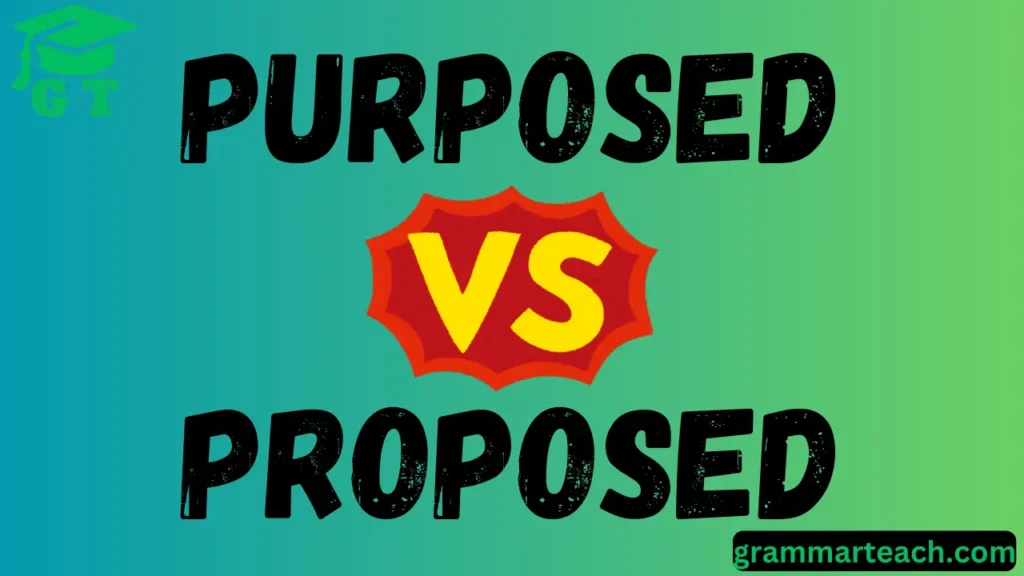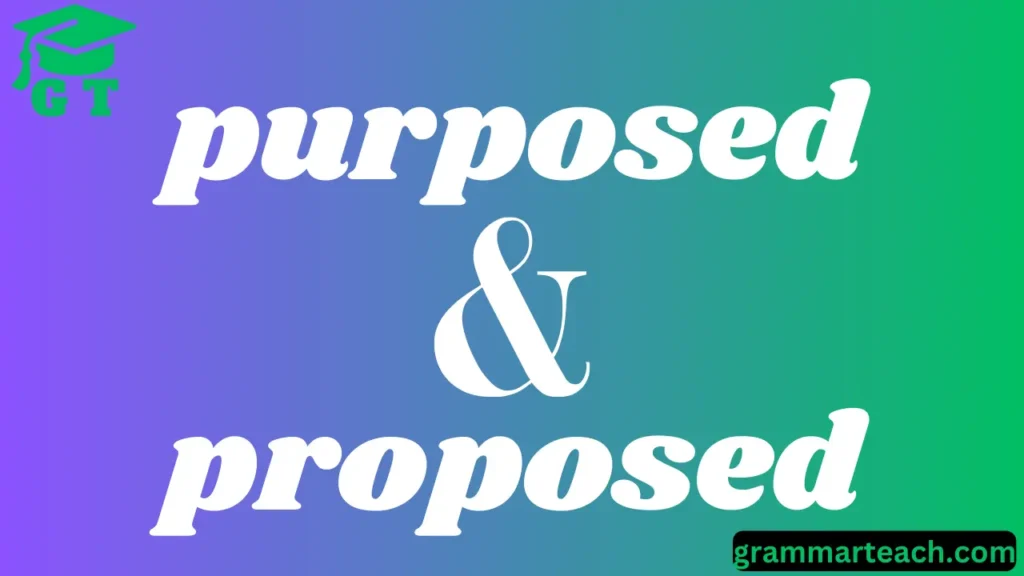Have you ever found yourself puzzled over whether to use “purposed vs proposed” in your writing? You’re not alone. These two terms are often a source of confusion due to their similar spellings and pronunciations. However, they convey distinct meanings and are used in different contexts.
Many people struggle with differentiating between these words, especially in academic and professional settings where precision in language matters. Misusing one in place of the other can lead to misunderstandings, making it important to grasp their correct meanings. “Purposed” and “proposed” both deal with intentions and plans, but from different angles.
This article aims to demystify these terms by exploring their definitions, differences, usage examples, and common pitfalls. By the end, you will have a clear understanding of when to use “purposed” and when “proposed” is the better choice, ensuring your writing is accurate and effective.
Purposed vs. Proposed – What’s the Difference?

At first glance, “purposed vs proposed” might appear interchangeable, but they serve different functions in the English language.
- Purposed: This term relates to having a specific intention or plan. When something is “purposed,” it is done with c aim or design.
- Proposed: This term means to suggest an idea, plan, or action for consideration by others. When something is “proposed,” it is put forward as a suggestion or recommendation.
The confusion often arises because both words deal with intentions and plans, but understanding their distinct roles can enhance clarity in communication.
Read More: Adjectives for O: Best Descriptive Words That Start with O
What Is “Purposed”?
Definition
“Purposed” is the past tense and past participle form of the verb “purpose.” It denotes that an action was performed with a specific intention or objective in mind, meaning that the action was deliberately planned and executed with a definite goal. This word emphasizes the intentional nature behind a particular action, distinguishing it from casual or spontaneous occurrences.
In literature and formal writing, “purposed” is often used to describe actions that were taken with a distinct aim in mind. Unlike “proposed,” which suggests offering an idea for consideration, “purposed” focuses on an already determined course of action. Understanding this nuance helps in using the term accurately and avoiding common misinterpretations.
Usage in Sentences
- The architect purposed the design to maximize natural light.
- The policy was purposed to reduce environmental impact.
Contextual Usage
“Purposed” is often used in formal or literary contexts to emphasize intentionality behind an action. It’s less common in everyday conversation but prevalent in academic, legal, or strategic discussions.
What Is “Proposed”?
Definition
“Proposed” is the past tense and past participle form of the verb “propose.” It refers to the act of suggesting a plan, idea, or course of action for others to consider, often with the intention of seeking approval, discussion, or modification. Unlike “purposed,” which conveys a determined intent behind an action, “proposed” focuses on offering a possibility rather than executing a decision.
The term “proposed” is frequently used in professional, academic, and casual conversations when introducing new ideas, policies, or strategies. When someone proposes something, they are putting forth a recommendation or suggestion that may be subject to debate, revision, or acceptance. Understanding this distinction helps prevent miscommunication, ensuring that the correct term is used based on the intent behind the statement.
Usage in Sentences
- She proposed a new method for data analysis.
- The committee proposed changes to the existing regulations.
Contextual Usage
“Proposed” is commonly used in both formal and informal settings. It’s frequently employed in business meetings, academic discussions, and everyday conversations where suggestions or recommendations are made.
Key Differences Between “Purposed” and “Proposed”

Understanding the distinctions between these terms is crucial for precise communication. Here’s a comparative overview:
| Aspect | Purposed | Proposed |
| Definition | Indicates an action done with a specific intention or plan. | Refers to suggesting an idea or plan for consideration. |
| Common Usage | Emphasizes deliberate intent behind actions. | Involves putting forward suggestions or recommendations. |
| Context | Formal, literary, academic, or strategic discussions. | Business meetings, academic settings, everyday conversations. |
| Grammar Role | Verb (past tense and past participle of “purpose”). | Verb (past tense and past participle of “propose”). |
| Common Mistakes | Misused in place of “proposed” when suggesting ideas. | Misused in place of “purposed” when indicating intentional actions. |
Example Scenarios Illustrating the Difference
Business Context
| Scenario | Purposed | Proposed |
| Goal Setting | The team purposed to increase market share by 15% this year. | During the meeting, John proposed launching a new advertising campaign. |
| Strategic Planning | The manager purposed a new approach to improve efficiency. | Sarah proposed changing the project timeline to ensure better execution. |
Academic Setting
| Scenario | Purposed | Proposed |
| Research Goals | The researcher purposed to explore the effects of climate change on marine life. | In her thesis, she proposed a new theory on cognitive development. |
| Study Plans | The professor purposed a detailed analysis of historical events. | The student proposed a new perspective on economic policies. |
Why Do People Confuse “Purposed” and “Proposed”?
Several factors contribute to the confusion between these terms:
- Similar Spelling and Pronunciation: Both words share a similar structure, leading to visual and auditory confusion.
- Overlapping Themes: Both relate to intentions and plans, but from different angles—one from the standpoint of having a plan (“purposed”), the other from suggesting a plan (“proposed”).
- Lesser-Known Usage: “Purposed” is less commonly used in everyday language, making its correct application less familiar to many.
Synonyms and Antonyms
Understanding synonyms and antonyms can further clarify the distinctions between these terms.
| Word | Synonyms | Antonyms |
| Purposed | Intended, planned, aimed, designed | Accidental, unintentional, spontaneous |
| Proposed | Suggested, recommended, offered, presented | Rejected, opposed, withdrawn, dismissed |
Practical Tips for Writers
To ensure correct usage of “purposed vs proposed,” consider the following tips:
- Determine the Intent: If you’re referring to an action carried out with a specific intention, use “purposed.” If you’re mentioning an idea or plan suggested for consideration, opt for “proposed.”
- Substitute Synonyms: Try replacing the word with a synonym. If “suggested” fits, then “proposed” is likely correct. If “intended” fits, then “purposed” is appropriate.
- Context Matters: Remember that “purposed” often appears in more formal contexts, while “proposed” is widely used in both formal and informal settings.
Read More: Meaning of WTW: What It Stands For & How to Use It
Final Thoughts
Mastering the distinction between “purposed” and “proposed” enhances clarity and precision in communication. “Purposed” conveys intentionality behind an action, while “proposed” suggests an idea for consideration. By understanding these unique meanings and applications, you can use the correct term confidently in writing and speech, avoiding common linguistic pitfalls.
Language precision matters, especially in academic, business, and professional settings where miscommunication can lead to misunderstandings. Recognizing the differences between “purposed” and “proposed” ensures that your ideas are expressed with clarity. Keep practicing these distinctions, and soon, choosing the right word will become second nature!




